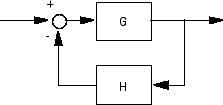inv
Invert models
Syntax
inv
Description
inv
inverts the input/output relation
to produce the model with the transfer matrix .
This operation is defined only for square systems (same number
of inputs and outputs) with an invertible feedthrough matrix D. inv handles
both continuous- and discrete-time systems.
Examples
Consider
At the MATLAB® prompt, type
H = [1 tf(1,[1 1]);0 1] Hi = inv(H)
to invert it. These commands produce the following result.
Transfer function from input 1 to output...
#1: 1
#2: 0
Transfer function from input 2 to output...
-1
#1: -----
s + 1
#2: 1
You can verify that
H * Hi
is the identity transfer function (static gain I).
Limitations
Do not use inv to model feedback connections
such as

While it seems reasonable to evaluate the corresponding closed-loop transfer function as
inv(1+g*h) * g
this typically leads to nonminimal closed-loop models. For example,
g = zpk([],1,1) h = tf([2 1],[1 0]) cloop = inv(1+g*h) * g
yields a third-order closed-loop model with an unstable pole-zero
cancellation at s = 1.
cloop
Zero/pole/gain:
s (s-1)
-------------------
(s-1) (s^2 + s + 1)
Use feedback to avoid such pitfalls.
cloop = feedback(g,h)
Zero/pole/gain:
s
-------------
(s^2 + s + 1)